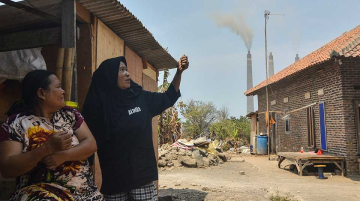
Chinese hydropower dams have helped Cambodia maintain its much-needed electricity supply. But relying on hydroelectric power alone is not enough and has proved to be dangerous for local people and their surroundings. Achieving true energy security for Cambodia could mean that it must consider temporary difficult options, like coal while diversifying its renewable energy sources.
Cambodia has struggled to provide an affordable and uninterrupted supply of electricity. Today, a household has to pay around US$0.25 per kWh. This is expensive compared to the electricity rate in Cambodia’s neighbors, which ranges between $0.139 and $0.141 per kWh in Thailand and around $0.073 to $0.078/kWh in Vietnam. It has put the burden on regular Cambodians to cut back on electricity usage. People are afraid to turn on air conditioners, despite climbing temperatures.
It is also preventing Cambodia from becoming an upper middle-income country by 2030 – a top goal set by the new Prime Minister Hun Manet. For one, if farmers can’t afford electricity, it dims the prospect of agricultural transformation. Giant industries like manufacturing would also find it difficult to build factories in Cambodia.
We have to admit that without China-backed hydropower dams – built since the 1990s – Cambodia could have been in an even more precarious situation. In 2015, China finished constructing six hydropower dams in the Northeast provinces, making up 47% of the total energy in Cambodia.
Three years later, a 400-megawatt hydroelectric power station called Lower Sesan 2 was inaugurated in Stung Treng province. The $800 million project was financed by China Hwaneng Group in partnership with the Prince Group, one of Cambodia’s largest conglomerates. Together, the hydropower dams provided 51% of the kingdom’s total electricity supply in 2018.
The dams were hoped to reduce the cost of electricity and in turn, alleviate poverty in the country. Electricity from the facilities is mostly channeled to Phnom Penh and other business centers.
Without China, Cambodia would have been in a worse position. But, it is time for Cambodia to step up its energy game, diversify, and better strategize for a future that does not leave any group or people behind.
Still, it remains insufficient. Even after importing electricity from neighboring countries like Laos, Vietnam, and Thailand, blackouts in Cambodia’s urban areas are still common.
There is also another urgent problem. The prized hydropower dams are affecting Cambodia’s indigenous populations, submerging farms, and destroying crops.
The construction of the lower Sesan 2 Dam in Stung Treng province, for example, caused flooding for people who live in nearby villages, particularly Kbal Romeas. In 2018, it was estimated that around 5,000 people coming from different ethnic groups such as Bunong Kuoy, Lao, Jaria, Kreung, and Tampuon were affected by the dam.
The dam also submerged farmland and destroyed crops in a village near the Sesan River. This contradicted the narrative from pro-government media outlets who had said that the reservoir could provide sufficient water for farming.
Prior to the construction, locals had been encouraged to move out of their villages. Many refused. For them, moving away means abandoning their ancestral land, the gravesites of their ancestors, and also their spiritual beliefs, which are attached to the village.
Forcing the local people to move from their village means they are being denied their own beliefs. This concept is recognized in Cambodia’s 2001 Land Law.
In 2020, the Cambodian government temporarily banned any new dam construction for the upcoming decade. It was a welcomed move by advocates and campaigners, and it brought hope to the people who live along the Mekong delta in Stung Treng province.
However, in 2022, Cambodia backtracked its decision when the Ministry of Mines and Energy approved a request from Cambodia’s Royal Group and China (Cambodia) Rich International to build a 1,400mw hydropower dam in Stung Treng province. In a Mongabay interview with local people, the dam is reported to potentially affect 1,000 people in four villages surrounding Koh Snaeng and the Stung Treng Ramsar, whose livelihood depends on fishing and farming.
Achieving National Energy Security Ethically
Cambodia’s efforts to secure energy supply must take into account the plights of indigenous groups, local villagers, and the overall condition of the environment and ecosystem in the region.
In this regard, relying solely on Chinese hydropower dams might not be the best solution.
On top of the impact on local communities mentioned above, we also know that the Mekong River is drying up and is in “its worst condition in 60 years”, as a result of global warming and rapid dam construction in upper Mekong and its tributaries.
The Cambodian government can instead diversify its renewable energy sources, like solar and wind, and consider using coal plants at a minimum level. While coal is not an ideal energy source, Cambodia’s dire need for electricity leaves the country with very little choice.
A variety of sources of electricity can provide a more secure supply for Cambodia.
Last year, the Cambodian government approved a planned construction of a solar panel factory in the UBE Snoul Special Economic Zone in Trapaing Sre village, Kratie province. The solar panel plant will be built by L-Q New Energy, a unit of Chinese solar cell manufacturer.
This is a step in the right direction, despite the fact that the electricity produced from this factory will most likely be exported. At the very least, this investment could push the Cambodian government to attract more funding into solar and open a pathway for skill and technology transfer to local companies. Eventually, the local companies could produce solar panels for domestic use.
In other words, China has so far played a critical role in supporting Cambodia’s energy development. Without China, Cambodia would have been in a worse position.
But, it is time for Cambodia to step up its energy game, diversify, and better strategize for a future that does not leave any group or people behind.
Sokvy Rim is a research fellow at the Cambodian Institute for Cooperation and Peace (CICP). His research interests focus on Cambodia’s foreign policy and its engagement with China and Southeast Asian countries.




